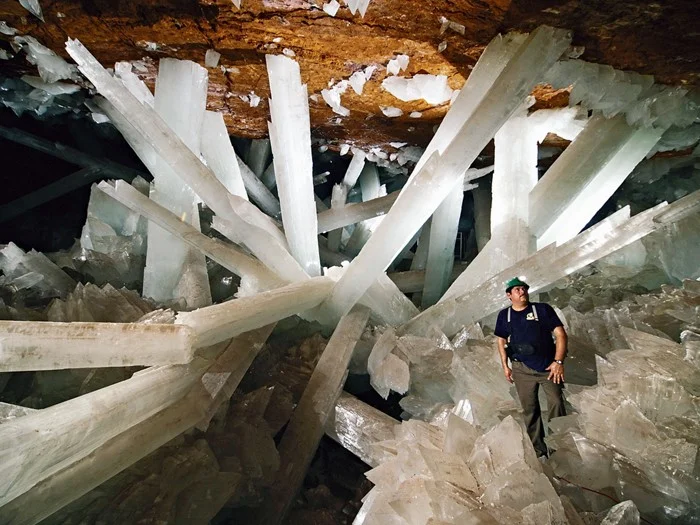Cave of Crystals

Written By
Madilyn Heller
In April 2000 a large underground chamber of crystalline structures was discovered in the Naica mine in Mexico…the Cave of Crystals. This chamber measures 109 meters (357.6 feet) in length and takes on a horseshoe- shape with a vast volume of almost 6,000 cubic meters (19,685 cubic feet).

The widespread discovery of large natural cavities containing a colorless crystalline variety of gypsum -known as selenite- has been increasing since the early 20th century. These cavities tend to occur close to fractures in limestone that sit above underground magma chambers, creating the perfect environment for crystal growth.
But how did the Cave of Crystals come to be? And how can these crystalline structures be so gigantic in size?
Well, around 26 million years ago, the Naica Mountain range was formed after some intense volcanic activity. As magma was drawn upward, underground cavities filled with anhydrite – a calcium sulfate predecessor to selenite gypsum- began to form. Anhydrite is only stable at temperatures above 58 degrees Celsius (136.4 degrees Fahrenheit). When the magma began to cool and the temperature began to drop, these anhydrite pockets started to fill with water. Anhydrite is soluble in water, and as the anhydrite structures started to dissolve, the water became enriched with sulfate and calcium minerals. This created the perfect recipe for selenite gypsum crystals to precipitate as the temperature and pressure in the chamber continued to decrease. Thus, the formation of selenite in the Cave of Crystals began.
Modern dating techniques have aged some of the largest crystals (reaching up to 11 meters -or 36.1 feet- in length) in the cave to be over 500,000 years old. However, if we look at the specific crystal growth rate we can expect these structures to have taken twice that long to reach their current size. Untouched by natural hindrances and human intervention, these crystals have been given the space and time to reach such heights and marvelous sizes.
Unfortunately, for those who are crystal enthusiasts, the Cave of Crystals is unreachable to humans now. Temperatures in the cave can exceed 58 °C with 99 % humidity, making conditions extremely hazardous for most vertebrate life. Since mining operations on Naica Mountain have ceased the cave has filled with water yet again. No longer explorable or touchable by humans, the vast chamber of selenite lives on in the darkness of the Naica Mountain. Growing and beating with the heartbeat of the earth, who’s to say what will happen to the Cave of Crystals?










